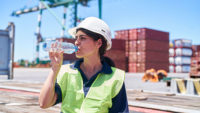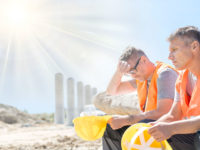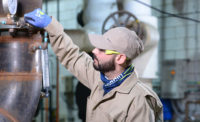The following is an interview with Dr. Douglas J. Casa, CEO of the Korey Stringer Institute, Professor, Department of Kinesiology, University of Connecticut.
The Bureau of Labor Statistics reports that 11 labor workers are seriously injured or die from heat stress each day in the United States.
We sat down recently to talk to Dr. Douglas J. Casa, CEO of the University of Connecticut-based Korey Stringer Institute (KSI). The mission of the KSI is to provide research, education, advocacy and consultation to maximize performance, optimize safety and prevent sudden death for the athlete, warfighter and laborer.
Dr. Casa’s particular focus is on preventing heat-related illness and death. To date, he has treated 325 cases of exertional heat stroke with zero fatalities and published nearly 300 peer-reviewed publications and book chapters on the subject. A survivor of exertional heat stroke (EHS) himself, he is one the world’s foremost authorities on EHS and heat illness and is often called in to investigate heat injuries or deaths on the job.
His latest project is to partner with two PPE manufacturers to create the nation’s first National Heat Safety Coalition. The coalition will assemble leading safety experts and researchers to provide awareness and educational tools, validate new and existing heat-safety solutions and technologies, and establish guidelines and leading practice recommendations to keep industrial laborers safe in the heat. Ultimately, they envision the coalition to be much like those that exist for fire-resistant gear and fall protection today.
M.B. Sutherland: Are there any differences in your (heat safety) recommendations based on sports vs. military vs. industrial, or is it basically a body is a body?
Dr. Douglas J. Casa: “No, there are differences. For instance, in (the) military you have people in training, you have people doing work, and then you have people fighting — so different situations. And then you could have people who are entry-level soldiers or war-fighters, (and others are) Special Forces people (who) tend to be the fittest people. Those people could tolerate more (heat) than someone in basic training. That gives you an idea of how it can be different.”
Dangers of exertional heat illness
MBS: What is the most dangerous part of exertional heat stress?
DC: “Ironically, it depends on the person. We often say, heat stroke identifies your weakest organ. In some people the liver fails, some people the kidney fails, some people the muscles have massive issues, some people the brain, some people the heart, some people, their ability to exercise in the heat. Literally, for some people (after a heat stroke), their liver might be totally fine but (for) other people their heart’s bad. Sadly, for some of the most serious cases multiple organs can fail which often results in death.”
MBS: So those would be more fatalities, if there are multiple health situations?
DC: “Exactly right. Someone might survive, and it might be a kidney issue. They might have kidney dialysis for six months and then actually be okay after it. Some people might need a kidney transplant.”
MBS: You mentioned that we talk about the (heat stroke) deaths, but we don’t talk about heat injuries.
DC: “People (who have experienced) heat stroke, heat exhaustion, other heat illnesses – that takes people out of either work shifts or potentially out (of work) for days. It could make them more susceptible to a heat stroke later.
Someone having heat exhaustion on Monday, (they) come back on Tuesday. They might still be dehydrated from the heat exhaustion, they might still be weak, they might have other issues. You don’t go from heat exhaustion to heat stroke – but the heat exhaustion could be a telltale sign that this person is struggling in the heat and they could be more susceptible the next day.
People (sometimes) think that someone has a cramp, and then they have syncope (a milder form of heat illness), and then they have heat exhaustion, and then they have heat stroke – and it just isn’t like that. Most people when they have a heat stroke, they might have had some difficulty through the day, but they likely don’t have official heat illnesses beforehand. They could, but they don’t necessarily. People always see it as a continuum that people go through. It’s a continuum of severity, but it doesn’t mean it’s a continuum you’re traveling through on the way to heat stroke.”
Hydration & heat acclimatization
MBS: Why do you think people sometimes fail to take exposure to the heat seriously?
DC: “I think we have horrible education, especially for workers in the heat. So some of it could just be pure ignorance. They just don’t know the risk. It’s unfortunate, because in the larger corporations in America, they certainly know the risks. There’s an industrial hygienist there. There are safety people. They’ve had plenty of heat problems in the past. They’ve dealt with lawsuits. Every big company has, right? So they’re aware that heat poses threats, but that often does not make it down to the grassroots people—the everyday employee, especially your new employees. What kind of training are they going through? Do they know (how to stay safe in the heat)?”
Dr. Casa recommends that companies use a wet-bulb globe temperature (WBGT) monitor to determine the actual working temperature on a job site. A WBGT monitor can be used to modify physical activity and/or increase rest periods to keep workers safe in dangerously hot conditions. He explained that the weather report might say it’s 85 degrees, but conditions in the microclimate of a job site including sun exposure, humidity, and wind might be far more severe, as well as the heat specific to the equipment and surrounding environment of the work setting.
DC: “The environmental monitor I showed you, it has a five-year warranty on it and it’s $500. So that’s $100 a year for environmental monitoring for that situation. That’s very cheap. It’s ridiculously cheap. The amazing thing is that your workers are more productive when your temperature’s lower, so the little money you’re investing, you’re getting back in spades.”
MBS: Let’s talk a little about hydration. If you just give people enough to drink, what are the odds they’ll be okay vs. cooling?
DC: “You can still have a heat stroke and be hydrated. (You’re) much more likely to have a problem if you’re dehydrated. A lot of our industrial laborers are in remote settings. People have to plan ahead because that means we need more fluid when we’re leaving the town in the morning, and it needs to be cold. Do a work shift of 12 hours in the summertime, your water is going to be 100 degrees! So even if you have the right amount of water, it is completely not palatable. You’re just not going to (drink) the right (amount of) water. It’s not realistic. I believe it’s also the company’s responsibility to keep it cold. And cold for two or three hours is very different than cold for ten to twelve hours. It takes a little bit of effort.”
MBS: What are the most common misconceptions you run into?
DC: “People assume that hydration is the only thing that matters. There’s no question. Literally, we’ll sit down with people (after a heat injury) and companies are like, ‘well we had the fluids, we gave them fluids, they drank, and we don’t think he was dehydrated.’ Well, you missed the boat because (hydration) matters, and we care about it, but you still get super-hot while you’re hydrated because you didn’t modify the work-to-rest ratio based on the intensity and the environmental conditions. So we need (body) cooling strategies.
We also need to phase (the workers) in (to high-heat work). For example, a person starting work, never worked with a company in their life, and their first day is July 8th. They’ve done their training, and now they’re out in the heat. Thank god there are some companies now that will say, ‘it’s only a four-hour shift for the first week, it’s a seven-hour shift for the second week, and then the 12-hour shift.’ At least they’re letting this person phase into it, so now we’re letting heat acclimatization happen and it’s a much better person three weeks later versus sending them into a 12-hour shift.
It takes (the management) saying, okay, we’re losing a tiny bit of money because they’re not putting the full shifts in, but we’re still paying them. But we’re going to have this employee who’s not going to struggle, we’re not going to have the big lawsuit and the worker’s probably going to think we’re taking care of them because this seems to make a lot of sense.
You’re going to get more productive people, and you end up having less problems down the road. But you have to at least think a couple years ahead with that line of thinking to have all those strategies in place. You can’t just rely on five people in your corporate office and then you have literally 300 different work settings in the country.”
Cooling PPE
MBS: Let’s talk about body cooling technology. What makes an effective product?
DC: “The temperature gradient between your skin temperature and whatever the cooling item is – the greater the gradient, the faster you cool. So if your cooling towel is 70 degrees and your skin temperature is 95 degrees, that’s good. But if the towel is 60 degrees – it’s always better. You want to have the biggest difference between those two items. My ultimate goal is to try to get laborers to be safer. So (cooling PPE) is, for me, a vehicle to get there.”
MBS: If there’s one takeaway or lesson you want people to have, what would it be?
DC: “Without question, we can do much more to enhance heat safety for the laborer in America. We are at the tip of the iceberg right now. I’d say (we’ve done) 5 to 10 percent of our ultimate potential for helping laborers so far related to work in the heat. So it’s really untapped. It’s exciting that there’s potential there, but I also feel it’s unfortunate that people are not doing things that we’re completely aware should be done right now.”
Source: https://www.playsmartplaysafe.com/newsroom/videos/preventing-treating-exertional-heat-stroke/



